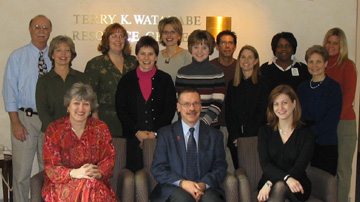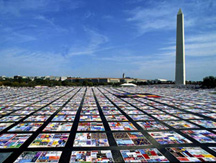The numbers are mind-boggling — 21.8 million people have died from AIDS since the disease was first identified in 1980.
But, that’s only part of the story.
Today, in recognition of World AIDS Day (Dec. 1), the world pauses to reflect on the scope of the disease and its human cost, as well as to honor the on-going heroic struggles waged to stem the tide.
 |
UNMC AIDS Clinic staff. Seated (L to R): Susan Swindells, M.B.B.S. (medical director, HIV Clinic); Joseph Hoagbin, M.D. (deputy director, HIV Clinic); and Edie Klingler, M.D. (staff physician). Second row (L to R): Sharon Richard (data manager); Deanna Hansen (administrative assistant); Jen O’Neill (clinic nurse); Shelley Ransom (program/regulations coordinator); and Frances Van Meter (research study nurse practitioner). Third row (L to R): Harry Naasz (case manager); Ann Fitzgerald (clinic nurse practitioner); Tacy Kirkendall (case manager); Daniel Cobos (outreach nurse coordinator); Sebrina Taylor (research assistant); and Sarah Starns (research study nurse). |
In the United States, an estimated 850,000 to 950,000 residents are living with HIV infections, one-fourth of whom are unaware of their infection. Approximately 40,000 new HIV infections occur each year and nearly half of these newly infected people are under the age of 25. As of Dec. 31, 2002, an estimated 501,669 people with AIDS have died in the United States.
“The theme of this year’s World AIDS Day campaign focuses on stigma and discrimination,” said Susan Swindells, M.B.B.S., medical director of UNMC’s HIV/AIDS Clinic. “Fear of discrimination and rejection causes reluctance to get tested for HIV and makes people unwilling to be open about their status. Sometimes people who know they are HIV-positive are even afraid to seek medical care.
|
|
In the United States, the creation of the AIDS Memorial Quilt has helped humanize the lives lost to AIDS, as well as change public attitudes toward people living with AIDS.
Cleve Jones, a gay rights activist in San Francisco, conceived the Memorial Quilt in November 1985. Since the 1978 assassinations of gay San Francisco Supervisor Harvey Milk and Mayor George Moscone, Jones had helped organize the annual candlelight march honoring these men.
While planning the 1985 march, he learned that more than 1,000 San Franciscans had been lost to AIDS. He asked each of his fellow marchers to write on placards the names of friends and loved ones who had died of AIDS. At the end of the march, Jones and others stood on ladders taping these placards to the walls of the San Francisco Federal Building. The wall of names looked like a patchwork quilt and one of history’s most unique memorial concepts was born. A year later, they created the first panel of the AIDS Memorial Quilt and in June 1987, formally organized the NAMES Project AIDS Memorial Quilt Foundation. Public response was overwhelming.
 |
This photo was taken in October 1996, the last time the entire AIDS Memorial Quilt was displayed. The Quilt covered the entire National Mall in Washington, D.C. |
On Oct. 11, 1987, the entire AIDS Memorial Quilt was displayed for the first time on the National Mall in Washington, D.C., during the National March on Washington for Lesbian and Gay Rights. It covered a space larger than a football field and included 1,920 panels. Half a million people visited the quilt that weekend. The tremendous response to this inaugural display led to a four-month, 20-city national tour of the quilt in the spring of 1988. Local panels were added at each city. The quilt returned to Washington, D.C., in October 1988, this time with 8,288 panels and, for the first time, celebrities, politicians, families, lovers and friends read aloud the names of every single person represented by a panel. The reading of the names is now a tradition at almost every quilt
display.
The Washington, D.C., displays of October 1987, 1988, 1989, 1992 and 1996 are the only ones that featured the quilt in its entirety. As of August 2003, there are 5,644 blocks making up the AIDS Memorial Quilt and most blocks are composed of eight individual panels –
representing more than 44,000 victims from all 50 states and 28 countries. Today there are 23 NAMES Project chapters in the United States and 46 independent quilt affiliates around the world. Since 1987, more than 14 million people have visited the quilt at thousands of displays worldwide and the NAMES Project Foundation has raised more than $3 million for AIDS service organizations throughout North America.
For more information, contact the Nebraska AIDS Project – the region’s largest social service agency devoted to HIV/AIDS education and people living with AIDS – at 552-9260 or www.nap.org. To learn more about HIV/AIDS discrimination and prejudice, visit the National AIDS Trust Web site at http://www.areyouhivprejudiced.org/speakout.